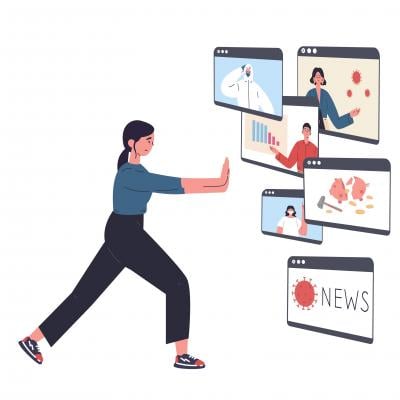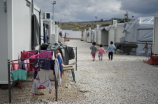How to Protect Your Family from Horrific News Images – and Still Stay Informed
How to Protect Your Family from Horrific News Images – and Still Stay Informed

The Russian invasion of Ukraine is a bitter reminder that there is no end to the horrific suffering that humans are sometimes willing to inflict on others.
Over the past several years, a seemingly endless stream of painful stories and images coming out of Syria, Yemen and now Ukraine – as well as mass shootings in the U.S. – have become a regular part of our daily life. With each passing day of the ongoing war in Ukraine and the gruesome news that it brings, many of us find ourselves checking the news the minute we wake up and last thing before going to bed.
Unlike some prior conflicts in other parts of the world, the inhumane actions of the Russian military in Ukraine have been very well publicized. Ukrainian citizens, the media and social media posts have done an excellent job of documenting images and videos of the war in Ukraine.
So by now, many of us have seen unforgettable images and videos of dead bodies, tortured civilians, burnt cars and destroyed buildings, repeatedly. This exposure often might even be unintentional; for instance, as we are scrolling through Twitter, Facebook or Instagram posts, we might come across a post conveying a very raw and painful story about the suffering of Ukrainian citizens.
I am a trauma psychiatrist and researcher who works with refugees, survivors of torture and human trafficking and first responders. In my work, I hear detailed stories of suffering from my patients that are painful to be privy to and that can have a negative impact on me and my colleagues. Through these experiences and my training, I have learned ways to protect myself from too much emotional impact while staying informed and helping my patients.
How images of disaster affect us
A wide body of evidence has shown that trauma affects not only those who suffer through it; it also affects other people who are exposed to the suffering in other ways. This is in part because humans are empathetic and social beings. Indirect and vicarious exposure to trauma often occurs in the lives of first responders, refugees, journalists and others, even when they do not directly experience the trauma themselves.
One means of exposure is through the news, especially when it is visual, animated and highly relatable. Previous studies have shown that exposure to news of terrorist attacks such as 9/11 could cause a wide range of emotional reactions, from symptoms of PTSD to depression and anxiety, in both adults and children.
Another risk of continuous exposure to horrible images is desensitization and numbing. This means some viewers might get too used to such images, seeing them as a new normal and being undisturbed by them.
How to protect yourself
Here are some practical tips on how to stay informed while minimizing harm:
– Limit the exposure: When I work with heavily traumatized patients, I collect the information I need to help the person, but I do not urge them to tell me more. In the same way, people can take in news in limited ways. In other words, learn what’s happening, then stop there. Avoid the urge for disaster voyeurism. If you have heard the story, you might not need to search for the images or the videos; if you have seen them, there is no need to revisit them over and over.
Studies have shown that exposure to media coverage following a collective trauma for several hours daily can lead to stress. So check the news a couple of times a day to be informed, but don’t continue seeking out coverage. The news cycle tends to report the same stories without much additional information.
– Limit the emotional intensity: The media’s mission is to inform the public about what is happening, but the nature of that storytelling can mean that disastrous news gets delivered in a highly emotional way. Reading the news can protect you somewhat from the emotionally charged nature of television or radio coverage. If you choose to tune in to television or radio, choose a reporter or anchor who presents information in a fact-based and less emotional way.
– Do not be lured into hours of scrolling through the same painful images from multiple different angles. Your emotional suffering will not reduce the victims’ suffering. I say this because some people might feel if they do not continue to follow the exposure, they are being insensitive or uninformed.
– Take regular time away from tuning in: If you have a strong urge to follow the news, at least give yourself several-hour breaks in between.
– Do not ignore or avoid other more positive news: Continuous exclusive exposure to disaster-based news will distort your perception.
– Know your limits: Some people are more sensitive and vulnerable than others to being affected by what they’re hearing or seeing.
– When you feel the negative impact, anxiety or sadness, reflect on it and know that this is a normal human reaction to other humans’ suffering. Then take respite in activities that can fully absorb your attention and emotionally recharge you. For me that outlet is high-intensity exercise.
– Talk to others: If affected, you can talk to loved ones and learn from others how they cope. If needed, seek professional help.
How to protect children
Children also often get exposed to such news and images, which could have negative effects on them. For younger children, repeated exposure to the news or to disturbing images might create an illusion that the event keeps repeating.
Here are some tips for limiting impact on children:
– Be mindful to not express overly charged negative emotions in front of children, who learn how safe or dangerous the world around them is largely from adults.
– Limit children’s exposure based on their age.
– When children are exposed to scary or upsetting news, talk to them about it in an age-appropriate way and explain what is happening in understandable language.
– Remind children that they are safe. For younger children, it might be important to remind them that these sad events are not happening where they live.
– Do not avoid their questions, but rather use them as an age-appropriate educational opportunity.
– If needed, seek professional help.
We can also reduce the negative impact on ourselves through helping others, especially those affected by these calamities. When I feel affected by the traumatic experiences of my patients, remembering that the end goal is helping them and reducing their suffering helps me process my feelings. Sadness, anxiety, anger and frustration can be channeled into actions such as attending fundraising activities and volunteering to help the victims. This can even be a family activity that teaches children a mature and altruistic response to others’ suffering.
[Over 150,000 readers rely on The Conversation’s newsletters to understand the world. Sign up today.]![]()
Arash Javanbakht, Associate Professor of Psychiatry, Wayne State University
This article is republished from The Conversation under a Creative Commons license. Read the original article.



















